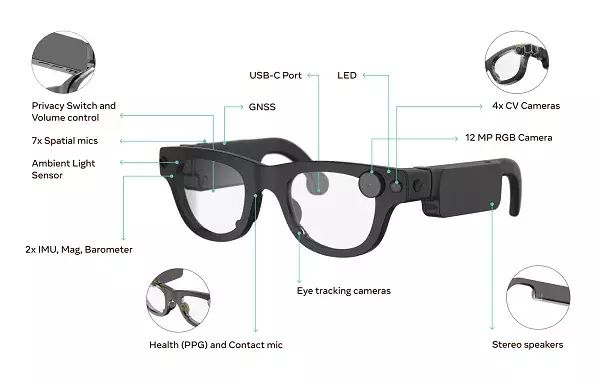In the rapidly evolving landscape of technology, augmented reality (AR) is poised to redefine our interaction with the digital realm. Meta, a pioneering force in this arena, is carving out its niche with the upcoming release of its second-generation “Aria” AR glasses. These innovative devices promise not only enhanced tech features but also a user-friendly design that prioritizes accessibility, comfort, and style. With Meta’s commitment to refining what AR can mean for everyday communication, the forthcoming glasses may set new standards in the wearable tech market.
A Stride Toward Practicality and Aesthetics
Meta’s recent insights into the Aria Gen 2 reveal a concerted effort to make AR glasses appealing not just technologically, but also culturally. The emphasis on lightweight design—averaging just 74-76 grams—while maintaining a fashionable appeal is a nod to consumer lifestyle preferences. Meta’s choice to incorporate folding arms is significant; it highlights the balance between integrating complex AR technology and ensuring that users can easily transport and store the device. This practical design choice could revolutionize how we perceive wearable technology, making it less of a novelty and more of an essential accessory.
By introducing eight different size variations, Meta is also embracing the diverse anatomies of potential users. This move cannot be overstated; it demonstrates that the company values inclusivity, understanding that a one-size-fits-all approach does not work in a world where individual differences should be celebrated. Such considerations not only enhance the usability of the glasses but also indicate Meta’s commitment to creating a device that feels personal and tailored to its user.
Technological Innovations Driving User Experience
The advancements in the technical specifications of Aria Gen 2 are equally impressive. Meta is reportedly integrating superior camera sensors that can function under varying light conditions, broadening the usability and effectiveness of the glasses. This upgrade addresses a common frustration with earlier electronic wearables—poor performance in diverse environments. Coupling this with an expanded field of view enhances the immersive experience, making interactions feel more natural and intuitive.
Notably, the inclusion of a contact microphone embedded in the nosepad is a clever innovation designed to improve audio capture amidst noisy surroundings. Imagine walking through a bustling city while conducting a conference call with clarity that was previously unattainable. Furthermore, the implementation of eye and hand tracking technologies will streamline intuitive interactions, allowing individuals to navigate digital content fluidly, perhaps with gestures that will soon become second nature.
The Future of Interaction: A Pair of Glasses or a World of Possibilities?
Mark Zuckerberg has referred to these AR devices as the “holy grail” of technology, proposing a future where functional connected glasses may replace smartphones as our primary means of digital interaction. This prediction signals a profound shift in how we socialize, work, and consume information. However, with such technological shifts come societal implications. As we imagine a future where people might interact with invisible interfaces—gesturing and speaking to devices that others cannot see—a new social norm will need to emerge.
The curiosity surrounding these experiences extends into the realm of human behavior. The initial awkwardness of seeing someone engaged in an augmented interaction will likely dissipate as these behaviors become integral to everyday life. Yet, this transformation raises questions about privacy and the boundaries of personal space in public settings.
An Open Gateway for Developers
Meta’s plan to open up Aria Gen 2 to external developers later this year marks a pivotal moment for the device. By inviting collaboration and innovation from a broader community, Meta is not merely selling a product but fostering an ecosystem of applications that could lead to unique augmented experiences. This impulsive move may stimulate creativity, resulting in purposes and uses that even Meta has yet to consider.
The timeline for a consumer launch in 2027 remains ambitious. However, it signals a sustained commitment to refining the technology before it reaches the market. As consumer expectations elevate, companies are under increasing pressure to ensure that such innovations are not only groundbreaking but also relevant and beneficial to everyday life.
Meta’s proactive approach with the Aria Gen 2 suggests an exciting horizon for AR technology, where the barriers between the physical and digital worlds are diminished, inviting users into an enriched and interconnected reality.


Leave a Reply